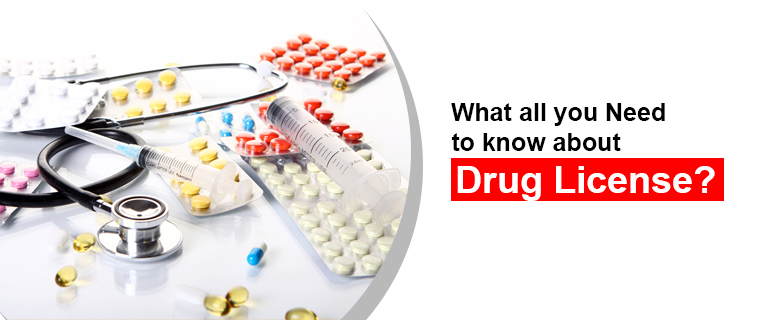What Is a Drug License and How to Apply for One?

Why a Drug License Is the Foundation of Pharma Operations
In the pharmaceutical industry, no activity can legally begin without proper authorization from regulatory authorities. Whether a business plans to manufacture medicines, distribute them, or sell them to end users, a drug license acts as the legal backbone of all pharmaceutical operations. It ensures that medicines circulating in the market meet safety, quality, and regulatory standards set by the government.
A drug license is not merely a document; it represents accountability. It confirms that a pharmaceutical business operates within approved guidelines, follows regulatory norms, and prioritizes patient safety. Governments enforce licensing systems to prevent the circulation of substandard, counterfeit, or unsafe medicines that could pose serious risks to public health.
For entrepreneurs entering the pharmaceutical sector, understanding drug licensing is often the first major challenge. The process involves regulatory compliance, documentation, inspections, and ongoing responsibilities. While it may seem complex, drug licensing creates a structured and transparent framework that protects both businesses and consumers.
This blog explains what a drug license is, why it is required, the types available, and how to apply for one through a clear, step-by-step explanation. It is designed to help manufacturers, distributors, wholesalers, and retailers understand the pharmaceutical drug licensing process in a practical and accessible way.

Understanding Drug Licenses and Their Role in Pharmaceuticals
What Is a Drug License and Why Is It Required?
A drug license is an official approval issued by a government drug regulatory authority that allows an individual or company to legally manufacture, distribute, or sell pharmaceutical products. It ensures that medicines are handled only by qualified and authorized entities operating in approved premises.
The primary purpose of a drug license is to safeguard public health. By regulating who can manufacture and sell medicines, authorities reduce the risk of poor-quality drugs entering the market. Licensing also ensures traceability, accountability, and regulatory control across the pharmaceutical supply chain.
In India, drug licenses are issued under the Drugs and Cosmetics Act, 1940, and regulated by State Drug Control Departments and the Central Drugs Standard Control Organization (CDSCO). Similar regulatory frameworks exist globally, each designed to monitor pharmaceutical activities within their jurisdiction.
Types of Drug Licenses in the Pharmaceutical Industry
Different pharmaceutical activities require different types of drug licenses. The license type depends on the nature of operations and the level of involvement in the supply chain.
- Manufacturing Drug License: Required for companies involved in producing medicines, formulations, or bulk drugs. This license ensures that manufacturing facilities meet regulatory and safety standards.
- Wholesale Drug License: Issued to businesses engaged in bulk distribution of pharmaceutical products to retailers, hospitals, or institutions.
- Retail Drug License: Required for pharmacies and medical stores selling medicines directly to consumers.
- Restricted Drug License: Applicable to sellers dealing with limited categories of medicines under specific conditions.
- Loan License: Allows a company to manufacture products using another licensed manufacturer’s facility.
Each license type comes with its own eligibility criteria, documentation requirements, and regulatory obligations.
How to Apply for a Drug License – Step-by-Step Process
The Pharmaceutical Drug Licensing Process Explained
Applying for a drug license involves more than submitting an application form. It is a structured process designed to verify infrastructure, personnel, compliance readiness, and operational intent. Below are the key steps involved, explained clearly.
- Determining the Correct License Type
Choosing the correct license is the first and most important step. Applicants must clearly define whether they intend to manufacture, wholesale, or retail pharmaceutical products. Applying under the wrong category can lead to delays or rejection.This step also involves understanding state and central jurisdiction, as some licenses are issued by state authorities while others require central approval.
- Preparing the Premises and Infrastructure
Regulatory authorities assess whether the proposed premises meet minimum requirements. For retail and wholesale licenses, space, storage conditions, and cleanliness are evaluated. Manufacturing licenses require far more extensive infrastructure, including production areas, equipment, and quality control facilities. Premises must support safe storage, proper segregation of medicines, and protection from contamination or damage.
- Appointing Qualified Technical Staff
Drug licensing regulations mandate the presence of qualified personnel. Retail pharmacies require a registered pharmacist, while manufacturing units require technical staff with pharmaceutical qualifications. Authorities verify educational credentials and professional registrations to ensure medicines are handled by competent individuals.
- Documentation and Application Submission
Applicants must submit detailed documentation, including identity proofs, premises ownership or rental agreements, staff qualifications, layout plans, and affidavits. Online portals are commonly used for submission, making the process more transparent and trackable. Incomplete or incorrect documentation is one of the most common reasons for application delays.
- Inspection by Drug Authorities
Once the application is reviewed, drug inspectors conduct a physical inspection of the premises. They assess compliance with regulatory requirements, infrastructure readiness, and operational capability. Any deficiencies identified during inspection must be rectified before approval is granted.
- License Grant and Validity
After successful inspection and verification, the drug license is issued. Licenses are typically valid for a specified period and require periodic renewal. Compliance must be maintained at all times, as authorities may conduct surprise inspections.
Compliance Responsibilities, Challenges, and Conclusion
Ongoing Responsibilities After Obtaining a Drug License
Obtaining a drug license is only the beginning. Licensed entities must continuously comply with regulatory standards to retain their authorization.
- Record Maintenance
Businesses must maintain purchase, sale, and stock records to ensure traceability and accountability.
- Storage and Handling Compliance
Medicines must be stored according to label instructions, especially temperature-sensitive products.
- Renewals and Amendments
Licenses must be renewed on time, and any changes in premises, staff, or business structure must be reported.
- Regulatory Inspections
Authorities may conduct routine or surprise inspections to ensure ongoing compliance.
Common Challenges in Drug Licensing
Many applicants face challenges such as unclear documentation requirements, delays in inspections, or lack of regulatory understanding. First-time applicants often underestimate the importance of infrastructure readiness and qualified staffing.
Engaging regulatory consultants, understanding local drug control rules, and preparing thoroughly can significantly reduce delays and rejections.
Conclusion
A drug license is a fundamental requirement for operating legally in the pharmaceutical industry. It ensures that medicines are manufactured, stored, and distributed in a controlled and regulated environment, protecting public health and maintaining market integrity.
Understanding the pharmaceutical drug licensing process helps businesses plan better, avoid regulatory pitfalls, and establish credibility from the start. While the process requires careful preparation and compliance, it ultimately creates a safer and more transparent pharmaceutical ecosystem.
For any pharmaceutical business—whether a small retail pharmacy or a large manufacturing unit—a valid drug license is not just a legal obligation but a symbol of trust, responsibility, and commitment to quality healthcare delivery.
Explore Related Blogs
Stay informed with our curated selection of similar blogs, offering expert perspectives on pharmaceutical trends, regulatory updates, and product innovations.
These articles are designed to help healthcare professionals, partners, and businesses stay ahead in an ever-evolving industry. Explore more to deepen your knowledge and make informed decisions.